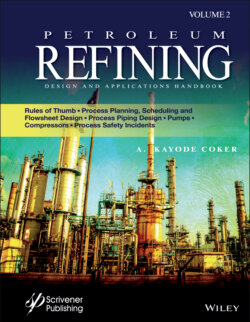Читать книгу Petroleum Refining Design and Applications Handbook - A. Kayode Coker - Страница 63
14.13 Working Schedules
ОглавлениеAs a direct companion of the completed flowsheet, the line schedule sheet transmits the process and mechanically necessary details for proper interpretation of the piping aspects of the flowsheet (see Figures 14.20a–d). These schedules are initiated by the process engineer to further explain the requirements of the process as shown on the flowsheets. They are often and perhaps usually cooperatively completed by other engineers, particularly the piping, mechanical and instrumentation groups.
Table 14.6 Instrumentation nomenclature--complete general identification.
| Modification of ISA Standards | |||||||||||||||
| First Letter | Second and Third Letters | ||||||||||||||
| Controlling Devices | Measuring Devices | Alarm Devices | |||||||||||||
| * Process Variable or Actuation | Recording | Indicating | Nonindicating (Blind) | Valves | Self-Actuated valve | Safety Valve | Recording | Indicating | Recording | Indicating | Nonindicating (Blind) | Primary Elements | Wells | Glass Devices for Visual Observation | |
| RC | IC | C | CV | V | SV | R | I | RA | IA | A | E | W | G | ||
| Flow | F | FRC | FIC | FV | FR | FI | FRA | FIA | FA | FE | FG | ||||
| Level | L | LRC | LIC | LC | LCV | LV | LR | LI | LRA | LIA | LA | LE | LG | ||
| Pressure | P | PRC | PIC | PC | PCV | PV | PSV | PR | PI | PRA | PIA | PA | PE | ||
| Speed | S | SRC | SIC | SC | SCV | SSV | SR | SI | SRA | SIA | SA | ||||
| Weight | W | WRC | WIC | WR | WI | WRA | WIA | WE | |||||||
| Analysis | A | ARC | AIC | AC | ACV | ASV | AR | AI | ARA | AIA | AA | AE | |||
| Hand | H | HIC | HC | HCV | |||||||||||
| Temperature | T | TRC | TIC | TC | TCV | TV | TSV | TR | TI | TRA | TIA | TA | TE | TW | |
| Special | X | XRC | XIC | XC | XCV | XSV | XR | XI | XRA | XIA | XA | XE |
Note: Blank spaces are impossible or improbable combinations.
Source: By permission from Oriolo D.J., Oil Gas J., Nov. 17, 1958; also see ISA Stds Latest edition.
A schedule similar to Figure 14.20a is used to summarize insulation process code or class, and pressure test information to the erection contractor. The process code is the complete code specification (as a separate fluid process service detailed for each fluid) tabulation for the required piping materials, fittings, valves, gaskets, thread lubricant, etc., for a specific process or utility fluid (see Figures 14.21 and 14.22). For example, it identifies the type of gate, globe, plug, check and needle valves to be used in the fluid by specific catalog figure number of a manufacturer or its equivalent. This requires attention to materials of construction, pressure–temperature ratings, and connections (flanged, screwed, weldend), bonnet type, packing, seat type (removable or non removable), stem, and any other details affecting the selection of a valve for the process fluid conditions. It also contains the specifications for pipe, fittings, flanges, unions, couplings, gaskets, thread compound, bolting, and any special materials needed to properly complete the piping requirements.
Other schedules and summaries include vessels (tanks and drums), towers or columns, heat exchangers, pumps, compressors, motors, trip, utility summary, hazardous chemicals and conditions, safety analysis table, etc. These are often developed by the process engineer for organizational uses by the process designers as well as by other engineering groups. Again, these are often cooperatively and sometimes completely prepared by a particular specialty group after interpreting and designing for the needs of the process, (Figures 14.23–14.28). These figures and many others (process data sheets) can be downloaded from the companion website.
Two types of schedules are in use:
1 1. The summary sheet, which summarizes process conditions and equipment selection.
2 2. The schedule sheet, which summarizes the key reference data for a particular class of equipment such as pumps, but contains no process data. The latter type is prepared for job coordination with and in the various departments, i.e., engineering, construction, purchasing, and production. It primarily serves for the construction period but, of course, does have lasting cross-reference value.
Figure 14.23 Centrifugal pump summary.
Figure 14.24a Centrifugal pump schedule.
Figure 14.24b Centrifugal pump schedule.
Figure 14.25 Vessel and tank summary sheet.
Figure 14.26 Vessel and tank schedule.
Figure 14.27 General services and utilities checklist.
From a construction viewpoint these summaries are a necessary checklist to aid in keeping the construction program organized. Individuals, who have no real knowledge of the scope of the job, and in particular the process, can properly tie the project together in the field by use of these schedules.
